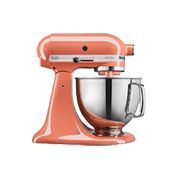Anatomy of a Knife
Anatomy of a KitchenAid Knife
KitchenAid® Knives are designed for superior performance when preparing meals. Whether cutting, slicing, dicing, chopping, mincing, or trimming, these essential kitchen tools deliver excellent results. Understanding the knife’s construction is important to optimize the use of KitchenAid® Knives. The following explains each part of the knife, as well as its purpose:
Handle
The handle is the part you hold while using the knife–it can be made of plastic, wood, or rubber. Scales are the handle parts that create its grip, accented with an endcap.
Tang
The tang is the part of the blade that extends into the handle, giving the knife balance.
Bolster
The bolster is the band that joins the blade of the knife to its handle. It provides balance for the knife and added comfort for your hand, while also keeping fingers away from the sharp edge of the blade.
Heel
The heel is the edge near the handle. This area of the edge cuts through large or tough foods with ease when pressure is applied.
Edge
The edge is the sharp cutting part of the blade. It extends from the point to the heel of the knife.
Spine
The spine is the dull top of the blade, opposite the edge. This part of the knife can be carefully pressed on for added control while cutting.
Tip
The tip is the forward quarter of the blade that includes the knife point, and it is best for cutting small or delicate foods.










.png)

























